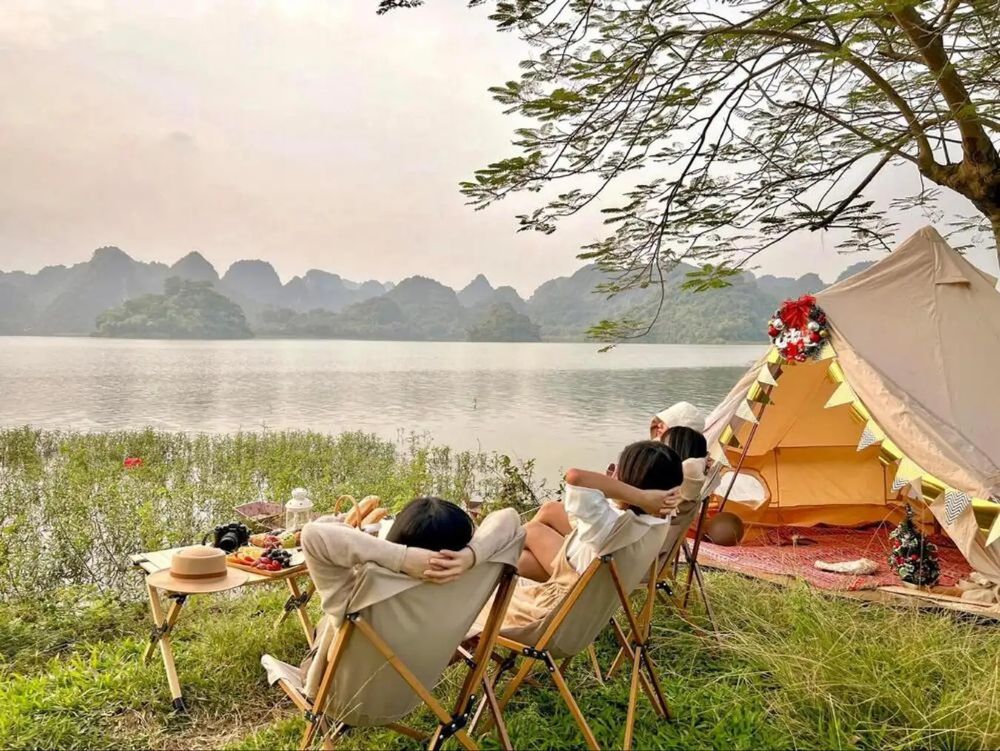Within the confines of Hanoi can be found a haven of peace and tranquility with a spectacular backdrop of mountains and water.
The waves lapped lightly against our boat as streaks of sunlight shyly peeked through a morning curtain of cloud. Fresh, breezy air whispered in my ears as a vast green carpet unfolded magically before my eyes. So this was Quan Son Lake, welcoming me in a peaceful manner and giving me an incredible sense of pleasure, just 50 km from bustling Hanoi.

Located in My Duc District, Quan Son Lake is also known as the ‘miniature Halong Bay’ of Hanoi, with spectacular natural scenery woven around hundreds of limestone mountains. For ‘busy bees’ like me the 850 ha ecological area is a splendid idea for a one-day escape since its unspoiled beauty offers little in the way of accommodation. If an overnight stay is in order, however, you can find a hostel right by the wharf on the lake’s dock and ask locals or the ferryman about where and what to eat.
Without hesitation, my friend Tung and I decided to drive down to the lake ourselves, which takes one to two hours. As we passed Te Tieu Bridge the sign for Quan Son Lake was eas to spot. We then proceeded along a narrow, long,, shaky ‘bridge’ to a pier, where two to three-hour boat tours around the lake are available, costing VND250,000 or around US$10 for a four-person boat that. While waiting for the next boat, I noticed a girl nearby with carrying a brown poodle and her boyfriend wanted a boat too, so we took the trip together.

A tanned ferry woman named Xuan greeted us with a smile as I stepped into her boat and immediately grabbed Tung for balance. The boat was rocking slightly and the water almost seemed to flood inside. “Don’t worry” – Xuan grinned sincerely. We soon relaxed to the rhythm of her rowing. The best time to visit the lake, she told us, is from May to June, when the picturesque sight of the pink lotuses floating on the water’s surface is accompanied by their gentle scent. “Hoa trang trang” or fragrant white Ixora ordorata, another species of white flower in the area, made for a flower carpet over the lake.
Slowly we passed by various mountains and landmarks on our way, such as ‘Nui Trau Trang’ (White Buffalo Mountain), ‘Dao Su Tu’ (Lion Island) and ‘Doi Voi Phuc’ (Voi Phuc Hill). It was, indeed, like a miniature Halong Bay. ‘If you come in October’, Xuan continued, ‘you can try our local shrimp. People usually go out and catch them in the afternoon. In winter we have fish salad, which is a mixture of dozens of leaves that only the locals know how to make.’ She finished with a twinkle in her eye and rowed the boat skilfully as another one passed by, propelled by the ferryman’s legs. ‘Oh’, I exclaimed in admiration, ‘It’s like he’s cycling! Is it that easy?’ Xuan shook her head with a shy warm smile.
She dropped us off at Hoa Qua Son Island (Fruit Mountain Island), which belongs to a local family. Most visitors come here for lunch since this is the only place that officially provides tourism services. It was like visiting a land of gardens with its many orange, litchi, and fig trees. At the entrance there is a large notice board with the ‘island rules’ and the service charges. Tung and I picked out a flat spot in the garden that looked suitable for enjoying lunch. We rented a mat and ordered some chicken and vegetables with rice. If you are in a group, it’s probably a good idea to prepare your own food. On the way to Quan Son you can stop at Van Dinh, which is famous for its ducks, and pick a restaurant that looks crowded (which usually means the food is good) and order some duck to go.
Fruit Mountain Island is full of green trees and I soon felt sleepy after lunch, immersed in the pure natural air. We asked Xuan to pick us up in three hours, so after a short nap we took a nice walk around the island and climbed up a small peak, which wasn’t so easy as it was rocky and there was no actual path. Standing at its top overlooking the lake and the mountains gave me a pleasant feeling of peace and relaxation.

Our boat returned and we continued our water journey around the lake from Treo Tranh Mountain to Linh Son Cave and Ngoc Long Cave. It was unbelievable to me how Mother Nature created all these amazing sites for people to relish. You could also visit pagodas on the lake, such as Cao Pagoda, Ham Yen Pagoda, and Linh Son Pagoda, which feature 17th century architecture.
Later on, we returned to the wharf. The sunlight was fading and it was time to hit the road. On the way there were two attractions that would be worth a visit: Boi Kho Pagoda and ‘Lang Chuong’ (Bell Village), where Vietnamese conical hats are made. We decided to save them for next time. The journey was a short but pleasant break from everyday life in a forest full of beautiful flowers, which reminded me that spring is was around the corner.
| Quan Son Lake is a scenic spot located in five different communes of My Duc District, a suburb of Hanoi, Vietnam. A small part of the lake extends to into districts of Hoa Binh province. It is about eight kilometers west of My Duc District center and about 50 km southwest of Hanoi city center. The lake was created in the 1960s on a 20 km long dike along Thuong Lam Commune to Lap Tien Commune. Initially, the lake was only used for irrigation, water supply and aquaculture. Later, the lake was exploited and commercialized for tourism. |
By Linh Maruko


